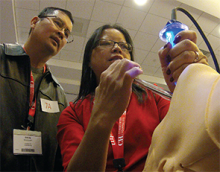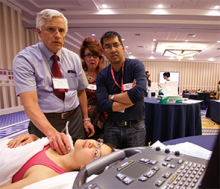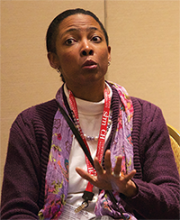User login
NATIONAL HARBOR, Md.—The conversation about hospitalists and technology can be pretty big. Rigmarole with rollout of an electronic health records (EHR) system is as much a rite of physician passage as Match Day. Administrators and C-suiters agonize over sprawling national initiatives (i.e., the Health Information Technology for Economic and Clinical Health [HITECH] Act of 2009) and the delayed implementation of the 10th revision of the International Statistical Classification of Diseases coding system (ICD-10). And there’s not an informatics officer in the country who doesn’t struggle with the term “meaningful use.”
Yet at HM15, one of the most interesting technology discussions wasn’t about the biggest of the big. In fact, it was about the smallest of the small: mobile applications, better known as apps. App usage on the ever-more-ubiquitous smartphones and tablets, used by patients and physicians alike, is a topic in its infancy. But hospitalist Roger Yu, MD, of Mayo Clinic in Rochester, Minn., says that hospitalists need to get ahead of the issue. He knows patients will soon start asking them more and more questions.
“Some of the older generation may not be savvy enough to utilize these apps themselves, but the next generation, who are these older patients’ caregivers, are savvy enough, and they are very facile with their use of mobile technology,” says Dr. Yu, who helped lead one of the annual meeting’s best attended workshops, “Dr. Hi Tech Hospitalist: Improving Quality and Value of Care Using Mobile Apps.”
“So we need to be able to advise them, because they will come to us as physicians thinking that we have expertise in this.”
Anuj Dalal, MD, FHM, a hospitalist at Brigham and Women’s Hospital in Boston, says that one of the impediments to knowing the best apps is the pure size of the marketplace. There are some 44,000 applications related to healthcare. Although the bulk of those are consumer-related applications focused on diet, fitness, and personal health, many can be resources for hospitalists. But first, medical professionals need the marketplace to develop a reliable app certification process, Dr. Dalal says.
“They will provide [physicians’ board] certification, and patients will start relying on them for advice just as you would rely on Consumer Reports,” he says. “I think that will help individual providers and patients decide what is a good app and what is an effective app, which apps they should use and which apps they shouldn’t use.”
Of course, some physicians frustrated with regulation prefer to see the government stay out of technology in healthcare. The FDA currently reviews apps with direct ties to medical devices, but the remainder of the app marketplace is wide open for some entity to fill the certification void.
“I think there are a lot of people who are fearful of overregulation, but right now I think we’re at the point of underregulation,” Dr. Yu says. “There’s a sweet spot. I think if there is a standard that people can meet, companies can meet, technologies can meet, that’ll give a lot of structure and guidance to people who want to make their own apps.”
Part of the difficulty of vetting apps is what Cheng-Kai Kao, MD, medical director of informatics at the University of Chicago Medicine, calls the “hype cycle.”
“When it first shows up, there’s a lot of hype, there’s a lot of hope for the technology, and you [drill] down, and eventually you find what’s real,” he says. “We are looking for what are the things that we hope mobile apps can really do.”
Hospitalist Lisa Bonwell, MD, of Colorado Health Medical Group in Colorado Springs, sees discharge as one useful time to work with patients via applications. She believes many patients would find electronic instructions delivered through their smartphone or tablet more useful than the deluge of paperwork many now receive.
“When I discharge a patient from our system, they get a stack of papers,” she says. “I was recently a patient in the ER. I looked at that [stack of paperwork] and said, ‘There is nothing useful here. This is ridiculous.’
“I mean, it’s all this medical, legal stuff [patients] have to have, so I think that really turns off people. This would be much more usable to them.”
Richard Quinn is a freelance writer in New Jersey.
NATIONAL HARBOR, Md.—The conversation about hospitalists and technology can be pretty big. Rigmarole with rollout of an electronic health records (EHR) system is as much a rite of physician passage as Match Day. Administrators and C-suiters agonize over sprawling national initiatives (i.e., the Health Information Technology for Economic and Clinical Health [HITECH] Act of 2009) and the delayed implementation of the 10th revision of the International Statistical Classification of Diseases coding system (ICD-10). And there’s not an informatics officer in the country who doesn’t struggle with the term “meaningful use.”
Yet at HM15, one of the most interesting technology discussions wasn’t about the biggest of the big. In fact, it was about the smallest of the small: mobile applications, better known as apps. App usage on the ever-more-ubiquitous smartphones and tablets, used by patients and physicians alike, is a topic in its infancy. But hospitalist Roger Yu, MD, of Mayo Clinic in Rochester, Minn., says that hospitalists need to get ahead of the issue. He knows patients will soon start asking them more and more questions.
“Some of the older generation may not be savvy enough to utilize these apps themselves, but the next generation, who are these older patients’ caregivers, are savvy enough, and they are very facile with their use of mobile technology,” says Dr. Yu, who helped lead one of the annual meeting’s best attended workshops, “Dr. Hi Tech Hospitalist: Improving Quality and Value of Care Using Mobile Apps.”
“So we need to be able to advise them, because they will come to us as physicians thinking that we have expertise in this.”
Anuj Dalal, MD, FHM, a hospitalist at Brigham and Women’s Hospital in Boston, says that one of the impediments to knowing the best apps is the pure size of the marketplace. There are some 44,000 applications related to healthcare. Although the bulk of those are consumer-related applications focused on diet, fitness, and personal health, many can be resources for hospitalists. But first, medical professionals need the marketplace to develop a reliable app certification process, Dr. Dalal says.
“They will provide [physicians’ board] certification, and patients will start relying on them for advice just as you would rely on Consumer Reports,” he says. “I think that will help individual providers and patients decide what is a good app and what is an effective app, which apps they should use and which apps they shouldn’t use.”
Of course, some physicians frustrated with regulation prefer to see the government stay out of technology in healthcare. The FDA currently reviews apps with direct ties to medical devices, but the remainder of the app marketplace is wide open for some entity to fill the certification void.
“I think there are a lot of people who are fearful of overregulation, but right now I think we’re at the point of underregulation,” Dr. Yu says. “There’s a sweet spot. I think if there is a standard that people can meet, companies can meet, technologies can meet, that’ll give a lot of structure and guidance to people who want to make their own apps.”
Part of the difficulty of vetting apps is what Cheng-Kai Kao, MD, medical director of informatics at the University of Chicago Medicine, calls the “hype cycle.”
“When it first shows up, there’s a lot of hype, there’s a lot of hope for the technology, and you [drill] down, and eventually you find what’s real,” he says. “We are looking for what are the things that we hope mobile apps can really do.”
Hospitalist Lisa Bonwell, MD, of Colorado Health Medical Group in Colorado Springs, sees discharge as one useful time to work with patients via applications. She believes many patients would find electronic instructions delivered through their smartphone or tablet more useful than the deluge of paperwork many now receive.
“When I discharge a patient from our system, they get a stack of papers,” she says. “I was recently a patient in the ER. I looked at that [stack of paperwork] and said, ‘There is nothing useful here. This is ridiculous.’
“I mean, it’s all this medical, legal stuff [patients] have to have, so I think that really turns off people. This would be much more usable to them.”
Richard Quinn is a freelance writer in New Jersey.
NATIONAL HARBOR, Md.—The conversation about hospitalists and technology can be pretty big. Rigmarole with rollout of an electronic health records (EHR) system is as much a rite of physician passage as Match Day. Administrators and C-suiters agonize over sprawling national initiatives (i.e., the Health Information Technology for Economic and Clinical Health [HITECH] Act of 2009) and the delayed implementation of the 10th revision of the International Statistical Classification of Diseases coding system (ICD-10). And there’s not an informatics officer in the country who doesn’t struggle with the term “meaningful use.”
Yet at HM15, one of the most interesting technology discussions wasn’t about the biggest of the big. In fact, it was about the smallest of the small: mobile applications, better known as apps. App usage on the ever-more-ubiquitous smartphones and tablets, used by patients and physicians alike, is a topic in its infancy. But hospitalist Roger Yu, MD, of Mayo Clinic in Rochester, Minn., says that hospitalists need to get ahead of the issue. He knows patients will soon start asking them more and more questions.
“Some of the older generation may not be savvy enough to utilize these apps themselves, but the next generation, who are these older patients’ caregivers, are savvy enough, and they are very facile with their use of mobile technology,” says Dr. Yu, who helped lead one of the annual meeting’s best attended workshops, “Dr. Hi Tech Hospitalist: Improving Quality and Value of Care Using Mobile Apps.”
“So we need to be able to advise them, because they will come to us as physicians thinking that we have expertise in this.”
Anuj Dalal, MD, FHM, a hospitalist at Brigham and Women’s Hospital in Boston, says that one of the impediments to knowing the best apps is the pure size of the marketplace. There are some 44,000 applications related to healthcare. Although the bulk of those are consumer-related applications focused on diet, fitness, and personal health, many can be resources for hospitalists. But first, medical professionals need the marketplace to develop a reliable app certification process, Dr. Dalal says.
“They will provide [physicians’ board] certification, and patients will start relying on them for advice just as you would rely on Consumer Reports,” he says. “I think that will help individual providers and patients decide what is a good app and what is an effective app, which apps they should use and which apps they shouldn’t use.”
Of course, some physicians frustrated with regulation prefer to see the government stay out of technology in healthcare. The FDA currently reviews apps with direct ties to medical devices, but the remainder of the app marketplace is wide open for some entity to fill the certification void.
“I think there are a lot of people who are fearful of overregulation, but right now I think we’re at the point of underregulation,” Dr. Yu says. “There’s a sweet spot. I think if there is a standard that people can meet, companies can meet, technologies can meet, that’ll give a lot of structure and guidance to people who want to make their own apps.”
Part of the difficulty of vetting apps is what Cheng-Kai Kao, MD, medical director of informatics at the University of Chicago Medicine, calls the “hype cycle.”
“When it first shows up, there’s a lot of hype, there’s a lot of hope for the technology, and you [drill] down, and eventually you find what’s real,” he says. “We are looking for what are the things that we hope mobile apps can really do.”
Hospitalist Lisa Bonwell, MD, of Colorado Health Medical Group in Colorado Springs, sees discharge as one useful time to work with patients via applications. She believes many patients would find electronic instructions delivered through their smartphone or tablet more useful than the deluge of paperwork many now receive.
“When I discharge a patient from our system, they get a stack of papers,” she says. “I was recently a patient in the ER. I looked at that [stack of paperwork] and said, ‘There is nothing useful here. This is ridiculous.’
“I mean, it’s all this medical, legal stuff [patients] have to have, so I think that really turns off people. This would be much more usable to them.”
Richard Quinn is a freelance writer in New Jersey.


